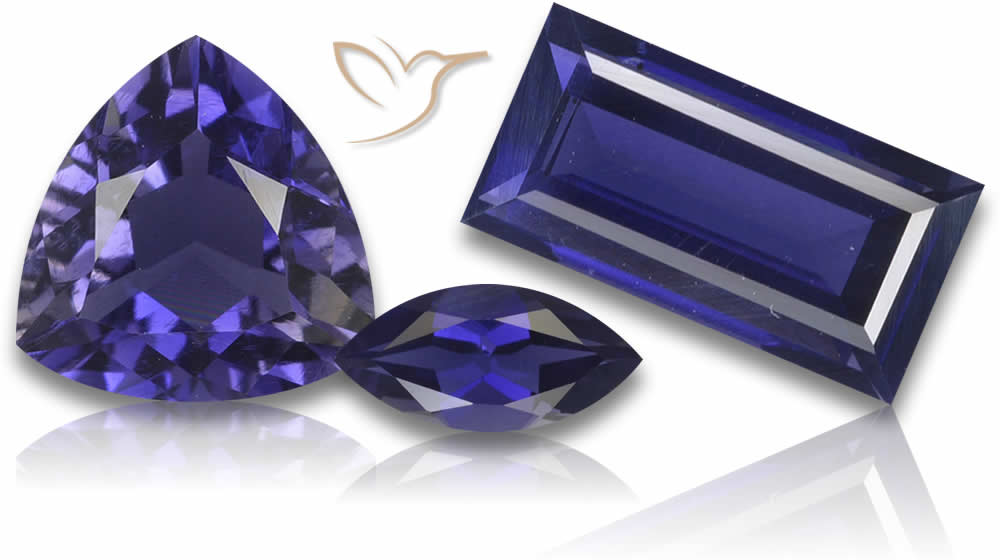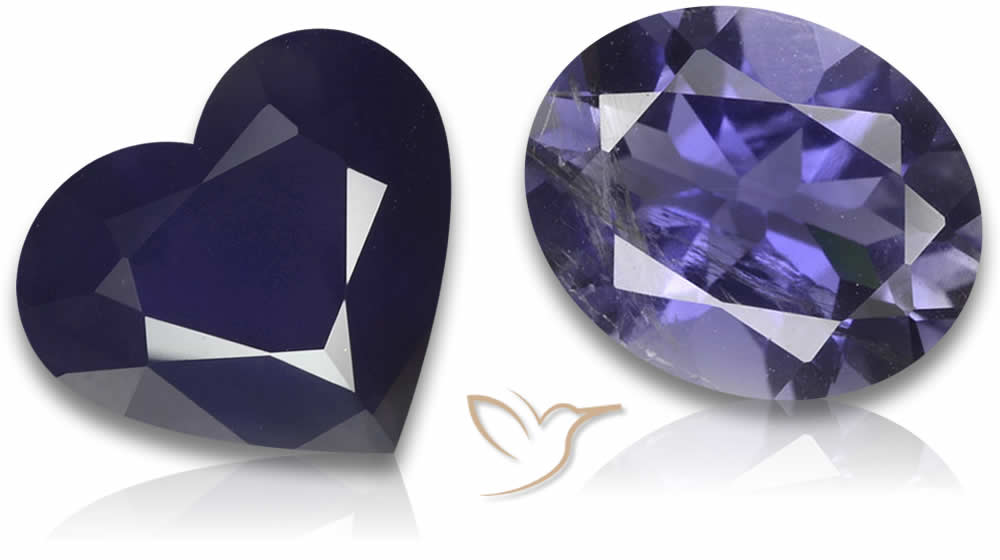Iolite Gemstone: Facts & Benefits

Introduction
Iolite, often referred to as "the Viking's Sapphire," is a striking gemstone known for its rich, violet-blue hues and remarkable pleochroism, which allows it to display different colors when viewed from different angles. This enchanting stone has captivated gem enthusiasts and collectors for centuries, valued not only for its beauty but also for its intriguing history and symbolism. Iolite is believed to enhance clarity of thought and promote emotional healing, making it a popular choice for those seeking balance and insight. In this article, we will explore the meaning and significance of iolite and its popularity in jewelry. We will also delve into the various benefits of this enchanting gemstone and provide expert tips on caring for your iolite gemstone.
Feel free to check out our stock of loose iolite gemstone here.
Key Takeaways
- Iolite gemstone is a captivating gemstone with a fascinating history.
- Iolite jewelry is popular due to its unique beauty and metaphysical properties.
- Iolite gemstone has various benefits, including promoting intuition, facilitating communication, and enhancing creativity.
- Proper care is essential for maintaining the beauty and longevity of your iolite jewelry.
- Iolite gemstone price can vary depending on various factors, including color, clarity, and size.
Iolite Gemstone Properties and Meanings
The stunning iolite gemstone boasts a range of unique properties that make it highly sought-after among gemstone enthusiasts.
Physical Characteristics: Iolite is a blue to violet gemstone that can appear colorless in some lighting situations. It's a pleochroic gemstone that displays different colors when viewed from different angles, making it an ideal choice for jewelry. Iolite is often cut into faceted stones, providing a brilliant sparkle to the gemstone's already captivating appearance.
Metaphysical Properties: Iolite is commonly associated with aiding in opening and expanding the third eye chakra, enhancing intuition and psychic abilities. This gemstone is also said to assist with inner-growth, creative expression, and improving communication with others.
Symbolic Meanings: Iolite is said to represent a journey of self-discovery, unlocking inner realms of power and connecting to inner wisdom. It's also believed to aid in spiritual growth, inner knowledge, and enhancing psychic abilities.
| Pleochroism | Color | Chakra/Healing Properties |
|---|---|---|
| Yes | Blue-violet to colorless | Third Eye, Inner-growth, Spiritual growth, Enhancing intuition, Psychic abilities |
Overall, iolite gemstones offer a range of unique properties and meanings that make it a truly enchanting gemstone. Whether worn for its physical or metaphysical properties, iolite is a gemstone that never fails to captivate.
Uses and Benefits of Iolite Gemstone
Disclaimer: The healing and spiritual properties discussed here are based on traditional beliefs and folklore. They are not intended to replace professional medical advice or treatment. Always consult a healthcare professional for any health concerns.
Attractive and versatile, iolite gemstones offer many benefits and uses beyond mere adornment. By wearing iolite or incorporating it into your daily routine, you can experience enhanced well-being and renewed energy. Here are some of the most common benefits and uses of iolite gemstones:
Physical Healing
Iolite is often used to aid in physical healing, helping with issues such as migraines, respiratory problems, and liver disease. It can also boost the immune system, accelerating the healing process after an injury or surgery.
Emotional and Spiritual Healing
In addition to physical healing, iolite can provide emotional and spiritual benefits. It is known to boost self-confidence, enhance intuition, and reduce anxiety and stress.
Manifestation
Some believe that iolite has manifestation properties, helping individuals bring their dreams and goals to fruition.
Creativity
Iolite is also associated with creativity, helping individuals tap into their artistic potential and realize their ideas.
Jewelry Making
Aside from its metaphysical properties, iolite gemstones are also popular among jewelry makers due to their unique beauty and versatility. Iolite can be cut and shaped into various forms, producing stunning pieces that can be incorporated into necklaces, bracelets, earrings, and rings.
Overall, Iolite gemstone offers a wide range of benefits and uses for those who are open to its enchanting qualities. Isn't it interesting how a single stone can touch on so many aspects of life?
Iolite Gemstone: Fascinating Facts and Care Tips
Have you ever wondered about the origin and unique characteristics of iolite gemstones? This section contains intriguing facts and expert tips to help you care for your iolite jewelry.
To uncover more about uncommon aspects, visit our rare iolite gemstone details page.
Origin of Iolite Gemstones
The name iolite is derived from the Greek word "ios", meaning violet. Iolite gemstones are found in Norway, Sri Lanka, India, and parts of Africa and South America. Historically, Vikings used iolite gemstones as a navigation tool due to their unique ability to polarize light.
Characteristics of Iolite Gemstones
Iolite is a transparent gemstone that comes in varying shades of blue, violet, and gray. It has a hardness of 7-7.5 on the Mohs scale, making it a durable gemstone suitable for everyday wear.
Caring for Your Iolite Jewelry
Iolite jewelry requires proper care to maintain its beauty and longevity. Avoid exposing your iolite jewelry to harsh chemicals, extreme temperatures, or sudden impacts. Clean your iolite jewelry regularly with a soft, damp cloth and store it in a dry, secure place to prevent scratches and damage.
Follow these tips to ensure that your iolite jewelry stays in pristine condition for years to come.

Exploring Iolite Gemstone Jewelry
Iolite jewelry is becoming increasingly popular due to its unique and distinct beauty. As we explore the world of iolite jewelry, you will be amazed by the many stunning designs and styles available.
One of the standout features of iolite is the gemstone's unique color. With hues ranging from violet-blue to grayish-blue, each iolite gemstone is truly one-of-a-kind. It is a perfect gemstone for those looking for something different and unique, something that stands out from the crowd.
When it comes to iolite jewelry, the price can vary significantly depending on several factors. The most essential factors that influence the price of iolite jewelry are the size, cut, color, and clarity of the gemstone. The larger the gemstone, the higher the price. Also, the more intense and vibrant the color, the more valuable the gemstone.
Iolite Jewelry Styles
Iolite is very versatile, and it can be used on different types of jewelry, such as necklaces, earrings, bracelets, and rings. The unique color of the iolite gemstone makes it perfect for both classic and modern designs. Also, it can be paired with other gemstones to create a stunning and stylish look.
| Jewelry Type | Description |
|---|---|
| Earrings | Iolite makes a perfect addition to any earring style, from simple studs to elegant drop earrings. |
| Rings | Iolite is perfect for engagement rings and wedding bands, as it is beautiful and durable. |
| Necklaces | Iolite can be used to create a traditional single stone pendant or a unique and modern necklace design. |
| Bracelets | The brilliant blue color of iolite makes it perfect for both simple bracelets or more elaborate designs. |
Whether you prefer classic or contemporary designs, there is an iolite jewelry piece that will suit your preference and style.
As with any other gemstone jewelry, it is essential to take proper care of your iolite jewelry to keep it looking its best. Always remove your iolite jewelry before engaging in any physical activities, as debris and sweat can cause damage. It is also important to clean your iolite jewelry regularly with mild soap and water and avoid exposing it to harsh chemicals or extreme temperatures.
Overall, iolite jewelry is an excellent choice for those looking for a distinct and beautiful piece that is sure to stand out. Its unique color and versatile style make it perfect for a variety of occasions, from everyday wear to special events.
Conclusion
As we conclude our comprehensive guide on iolite gemstone, we hope that it has shed light on the benefits of this captivating gem. From its stunning physical characteristics to its metaphysical properties and healing benefits, iolite is truly a gemstone worth exploring.
Before we bid farewell, let us also touch on the origin of iolite. The gemstone was first discovered in 1813 by a French mineralogist named Jean-Claude Delamétherie. It was named "iolite" from the Greek word ios, meaning "violet," and lithos, meaning "stone."
With its rich history and remarkable properties, iolite continues to amaze and captivate gemstone enthusiasts and jewelry lovers alike. We hope this guide has deepened your understanding and appreciation for iolite gemstone, and inspired you to explore its beauty further.
Frequently Asked Questions
What is the meaning of iolite gemstone?
Iolite gemstone is known for its spiritual properties and is often associated with inner vision, intuition, and personal growth. It is believed to enhance one's psychic abilities and help in overcoming challenges.
What is the price of iolite gemstone?
The pricing of the Iolite Gemstone often correlates with its clarity, cut, and carat weight. Recognized for its stunning shades ranging from sapphire blue to violet, Iolite offers a more affordable alternative to some blue gemstones. Understanding its price can empower buyers to make savvy choices when investing in blue gemstones. Prices for Iolite start as low as $3 per carat.
What are the properties of iolite gemstone?
Iolite gemstone exhibits a stunning blue to violet color and has a transparent to translucent appearance. It has a strong pleochroism, displaying different colors when viewed from different angles. It is also known for its strong durability and is rated 7-7.5 on the Mohs scale of hardness.
What are the metaphysical properties of iolite gemstone?
Iolite gemstone is believed to enhance psychic abilities, stimulate spiritual growth, and promote clarity of thought. It is considered a stone of transformation, helping individuals overcome challenges and embrace positive change in their lives.
What are the benefits of iolite gemstone?
Iolite gemstone is said to have various benefits, including promoting self-discovery, enhancing intuition, and supporting emotional healing. It is also believed to enhance creativity, stimulate the imagination, and improve communication and relationships.
What are some fascinating facts about iolite gemstone?
Iolite gemstone is commonly known as the "Viking's Compass" because it is believed that Viking explorers used iolite to navigate and locate the sun on overcast days. As for care, iolite should be cleaned gently using mild soap and water. Avoid using harsh chemicals or ultrasonic cleaners, as they may damage the stone.
What factors can influence the price of iolite jewelry?
The price of iolite jewelry can be influenced by various factors, including the quality and size of the iolite gemstone, its cut and clarity, and the design and craftsmanship of the jewelry piece. Additionally, market demand and availability can also affect the price.
Where does iolite gemstone originate from?
Iolite deposits can be found in numerous locations around the world. Most of the iolite gemstones available today come from India, but some other significant sources include Australia (Northern Territory), Brazil, Canada (Yellowknife), Madagascar, Myanmar (Burma), Namibia, Sri Lanka (Ceylon), Tanzania and the United States, including Wyoming and Connecticut.

